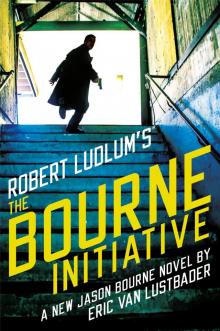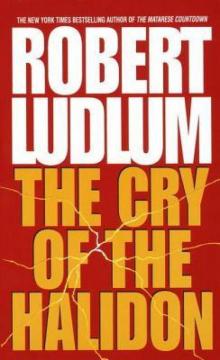- Home
- Robert Ludlum
The Arctic Event
The Arctic Event Read online
Copyright © 2007 by Myn Pyn, LLC
All rights reserved. Except as permitted under the U.S. Copyright Act of 1976, no part of this publication may be reproduced, distributed, or transmitted in any form or by any means, or stored in a database or retrieval system, without the prior written permission of the publisher.
Grand Central Publishing
Hachette Book Group
237 Park Avenue
New York, NY 10017
Visit our Web site at www.HachetteBookGroup.com.
The Grand Central Publishing name and logo are trademarks of Hachette Book Group, Inc.
First eBook Edition: September 2007
ISBN: 978-0-446-40212-5
Contents
Copyright
Prologue
Chapter One
Chapter Two
Chapter Three
Chapter Four
Chapter Five
Chapter Six
Chapter Seven
Chapter Eight
Chapter Nine
Chapter Ten
Chapter Eleven
Chapter Twelve
Chapter Thirteen
Chapter Fourteen
Chapter Fifteen
Chapter Sixteen
Chapter Seventeen
Chapter Eighteen
Chapter Nineteen
Chapter Twenty
Chapter Twenty-one
Chapter Twenty-two
Chapter Twenty-three
Chapter Twenty-four
Chapter Twenty-five
Chapter Twenty-six
Chapter Twenty-seven
Chapter Twenty-eight
Chapter Twenty-nine
Chapter Thirty
Chapter Thirty-one
Chapter Thirty-two
Chapter Thirty-three
Chapter Thirty-four
Chapter Thirty-five
Chapter Thirty-six
Chapter Thirty-seven
Chapter Thirty-eight
Chapter Thirty-nine
Chapter Forty
Chapter Forty-one
Chapter Forty-two
Chapter Forty-three
Chapter Forty-four
Chapter Forty-five
Chapter Forty-six
Chapter Forty-seven
Chapter Forty-eight
Chapter Forty-nine
Chapter Fifty
Chapter Fifty-one
Chapter Fifty-two
Chapter Fifty-three
Epilogue
PRAISE FOR
Robert Ludlum’s
Covert-One Novel Series
“Packed with all the classic Ludlum elements . . . The intricately engineered plot thunders forward at breakneck pace. Bottom line: Perfectly executed.”
—People on The Altman Code
“The cinematic chase through changing landscapes and mounting body count gives the books its rapid pace, while insider politics, tradecraft, and technical wizardry lend an extra kick.”
—Publishers Weekly on The Cassandra Compact
“A fast read and sure to delight fans of both espionage and the techno-thriller.”
—Booklist on The Lazarus Vendetta
“A solid intelligence, some really scary nanotechnology, and a writing style that always gets the job done.”
—Publishers Weekly on The Lazarus Vendetta
“The hero is brilliant, strong, and stoic . . . The international settings are spectacular.”
—reviewingtheevidence.com on The Altman Code
“Plenty of excellent shootouts.”
—Publishers Weekly on The Moscow Vector
THE COVERT-ONE NOVELS
The Hades Factor (with Gayle Lynds)
The Cassandra Compact (with Philip Shelby)
The Paris Option (with Gayle Lynds)
The Altman Code (with Gayle Lunds)
The Lazarus Vendetta (with Patrick Larkin)
The Moscow Vector (with Patrick Larkin)
The Arctic Event (with James Cobb)
ALSO BY ROBERT LUDLUM
The Ambler Warning The Parsifal Mosaic
The Tristan Betrayal The Parsifal Mosaic
The Janson Directive The Matarese Circle
The Sigma Protoco The Gemini Contenders
The Prometheus Deception The Holcroft Covenant
The Matarese Countdown The Chancellor Manuscript
The Apocalypse Watch The Road to Gandolfo
The Road to Omaha The Rhinemann Exchange
The Scorpio Illusion The Cry of the Halidon
The Bourne Ultimatum Trevayne
The Icarus Agenda The Matlock Paper
The Bourne Supremacy The Osterman Weekend
The Aquitaine Progression The Scarlatti Inheritance
ALSO BY JAMES COBB
Choosers of the Slain
Sea Strike
Sea Fighter
Target Lock
West on 66
Cibola
BY ERIC VAN LUSTBADER
Robert Ludlum’s The Bourne Legacy
Dedicated to Donald Hamilton
and his creation, Matt Helm
(The real Matt Helm, not the Hollywood version)
Prologue
March 5, 1953
The Canadian Arctic
Nothing lived on the island. Nothing could.
It was a jagged ridge of raw, storm-savaged rock thrusting through the ice and freezing waters of the Arctic Ocean only a short distance from the Earth’s magnetic pole. A shallow crescent twelve miles in length from east to west, it tapered from two miles in width at its broadest point to a quarter mile at its tips, with something of a cove on its westernmost end. Two prominent peaks rose out of its narrow, boulder-strewn coastal plain, a glaciated saddleback joining them.
Lichen and a few tufts of stunted, frost-burned sea grass clung to bare existence amid its fissured stone. A few kittiwakes and fulmars would roost on its cliffs during the brief arctic summer. The occasional seal or walrus would haul out on its gravel beaches, and the rare lordly polar bear would pad ghostlike amid its freezing fogs.
But nothing truly lived there.
The island was one of the myriad crumbs of continent scattered between the northern coast of Canada and the Pole. Collectively they were called the Queen Elizabeth Archipelago, and each was as bleak and blizzard blasted as the next.
For the bulk of its existence, the island had been unknown and unvisited by humanity. Some far-ranging Inuit hunter might have seen its peaks rising above the sea smoke on the distant horizon. If he had, the necessities of survival for himself and his tribe had prevented any further investigation.
Or possibly some Victorian-era arctic explorer caught up in the vain quest for the Northwest Passage might have sketched the island onto his crude map with a mittened hand. If so, his had been one of the ice-doomed ships that never returned.
The island and its sisters did not enter into the affairs of mankind until the coming of the appropriately named Cold War. The Queen Elizabeth Archipelago was photo surveyed in the late 1940s by the United States Air Force as a precursor to the construction of the North American Air Defense Command’s Distant Early Warning radar line. The island gained a name then. The bored military cartographer who added it to the world’s charts dubbed it Wednesday because it had to be called something and because its survey run had passed over his desk in the middle of the week.
Not long afterward, Wednesday Island received its first visitation.
A williwaw was blasting down from the Pole through the primordial darkness of an arctic winter, its winds screaming around the island’s peaks, scouring the snow from their northern faces, leaving the black basalt naked to the storm.
Possibly that was why the island went
unseen until it was too late.
Faintly, the sound of powerful aircraft engines came from the north, riding with the wind, growing swiftly in intensity. But there was no one to hear their thunder as they passed low over the island’s coastline. Too low. The roar of the engines suddenly increased, spurred into a howl of desperation-born power.
The howl ended abruptly in the harsh, tearing slam of metal hitting on ice, and the eternal winds shrieked in triumph.
Wednesday Island ceased to be a point of concern for another half century.
Chapter One
The Present Day
The Canadian Arctic
Clad in Day-Glo orange parkas and snowmobiling suits, the three rope-linked figures leaned on their ice axes, forcing themselves up the last few yards to their goal. They had made their climb on the southern face of the ridge, its bulk shielding them from the prevailing wind. But now, as they struggled over the lip of the small, bare rock plateau at its peak, the full blast of the polar katabatics raked them, the wind chill driving the effective temperature from merely below freezing to well below zero.
It was a pleasant autumn afternoon on Wednesday Island.
The pale, heatless ball of the sun rolled along the southern horizon, filling the world with the strange, grayish glow of the weeks-long arctic twilight.
Looking down at the surrounding ocean, it was difficult to tell island from sea. The pack was closing in around Wednesday, the new, living ice buckling and jumbling up on the beaches. The only leads of free, dark water to be seen trailed behind the drifting icebergs on the horizon as they resisted the frozen constriction of the coming winter.
To the east, the driving winds had drawn a snow squall across the far end of the island, blurring the second, taller mountain into an ominous dark bulk hinted at behind a ragged curtain of mist.
The vista was that of hell with the furnaces shut down, yet the three who viewed it were of the breed who found such sights exhilarating.
The team leader threw his head back and challenged the wind with a wild wolf howl. “I claim this mountain by right of conquest and hereby name it...What in the hell are we going to name it anyway?”
“You were first man up, Ian,” the smallest of the three climbers pointed out, her voice muffled by her wind mask. “So by rights it should be Mount Rutherford.”
“Agh, no! This should not be!” the third member of the climbing team protested. “Our lovely Miss Brown is the first lady to climb this formidable peak. It should be Mount Kayla.”
“That’s very sweet, Stefan, but it still won’t rate you more than a handshake back at the station.”
Ian Rutherford, an Oxford biology major, chuckled. “I suppose we shouldn’t worry about it. No matter what we might name it, we’ll just end up calling it West Peak as we always have.”
“You suffer from excessive realism, Ian.” Stefan Kropodkin, of McGill’s cosmic ray research program, grinned into the heavy woolen muffler that covered the lower half of his face.
“I think we need a little realism at the moment.” Kayla Brown was in geophysics at Purdue. “We’re already an hour off our schedule, and Dr. Creston wasn’t too happy about us coming up here in the first place.”
“Another man with little romance in his soul,” Kropodkin grunted.
“We still have enough time for a few photographs,” Rutherford replied, unslinging his rucksack. “Cresty certainly can’t object to that.”
They saw it as they cautiously worked around the perimeter of the tiny plateau, and it was the sharp eyes of the little geophysicist-to-be from Indiana who made the discovery.
“Hey, guys, what’s that? Down there on the glacier.”
Rutherford peered down into the saddle between the peaks. There was something there, just barely visible through the snow haze. He shoved his goggles up and pulled his binoculars out of their case. Being careful not to allow their frigid metal to touch his facial skin, he peered through them.
“Bloody hell! There is something down there!” He passed the field glasses to his friend. “What do you think, Stefan?”
The Eastern European looked for a long time. Then he lowered the binoculars. “It’s a plane,” he said wonderingly, “a plane on the ice.”
Chapter Two
Huckleberry Ridge Mountain Warfare Training Center
Lieutenant Colonel Jonathan “Jon” Smith U.S. Army, MD, stood with his back to the edge of the cliff and took his final look around.
It was beautiful up here. From this point, one could look southward along the western slope of the Cascade range, the mountains all stone blue-gray, snow-frost white and forest evergreen. Shreds of mist hovered protectively over the lower slopes, and the golden glow of the sunrise streamed through the notchbacks of the ridgeline. With a further twist of his head he could include the distant, shattered cone of Mount St. Helens in his field of vision, a thin haze of steam cupped in the volcano’s gaping crater.
It reminded Smith of long-past summers in Yellowstone, and the childhood pride and thrill of packing into the backcountry for the first time with his father and Uncle Ian.
The air especially, chill, sweet, and biting with life. He took a last deep breath of it, relishing the experience, and stepped backward off the edge of the precipice.
His horizon rotated a smooth ninety degrees, and the climbing harness gave him a reassuring hug as the thick green nylon rope laced through his carabiners took up the strain. With his weight held by the rappelling brake and the cleated soles of his Danner “Fort Lewis” mountain boots braced against the lichen-mottled black basalt, he stood on the vertical face of the cliff. He was still new enough to the experience that he grinned with exhilaration. By God, this was better than lab work!
“Okay, Colonel,” the loud-hailer–amplified voice of the instructor echoed up from the base of the cliff, “push off and take it easy.”
Above, Smith’s fellow students, clad in the same forest camouflage that he wore, peered over the cliff edge. This was the big drop, the 150-foot rappelling descent. The slack of the rope trailed away below him, and Smith gave it a final clearing flick. Then he snapped his legs straight, shoving away from the rock and allowing the line to feed through the brake.
In Smith’s continuing efforts to balance the wildly diverse aspects of his life, that of soldier, scientist, physician, and spy, this mountain warfare course had been a resounding success.
Over the last three weeks, he had thrown himself into the challenge of the program with a growing enthusiasm, hardening his body with the muscle-cracking wilderness training regime and clearing his thinking after too many days spent buried in the Fort Detrick laboratories of the U.S. Army’s Medical Research Institute of Infectious Diseases.
He had revived atrophied combat skills and had learned new ones: rough-terrain orienteering, hostile-climate survival, camouflage, high-angle marksmanship. And he had been introduced to the art of mountaineering. Smith had learned how to use crampons, pitons, and a rock hammer and more critically, how to trust in the rope and the harness, placing in abeyance the instinctive human fears of the fall and the high place.
The rappelling line zipped through the steel loops, the palm of Smith’s heavy glove warmed, and his boots jolted against the rock twenty feet farther down the face. He felt his eyes narrow and his face tighten as the adrenaline surge hit, and once more he pushed away and sheered off another forty feet of cliff.
“Easy, sir,” the voice from below warned.
For a third time he pushed off, hard, allowing himself to plummet, the rope screaming and the rappelling brake smoking.
“Easy, Colonel...Easy...Easy!...I SAID EASY, GODDAMN IT!”
Smith braked hard, arresting his fall. Pulling himself upright, he dropped boots-first the last few feet to the fir-needle duff at the cliff base. Backing off the bottom end of the rope, he rubbed the scalding heat pulse out of his glove and onto the thigh of his fatigues.
A stocky ranger sergeant in a sand-colored beret came up behind
him. “Begging the colonel’s pardon, sir,” he said sourly, “but I hope you realize that an officer can bust his ass up here just about as bad as an enlisted man or an NCO.”
“I’ll take your word for it, Top,” Smith grinned.
“Then when I say ‘EASY, SIR,’ I damn well mean it!” The climbing instructor was a twenty-year veteran of both the Seventy-fifth Ranger Regiment and the famed Tenth Mountain Division and thus was a rather privileged individual, even to a light colonel.
Smith sobered and undid the chin strap of his helmet. “I hear you, Sergeant. I got a little full of myself up there. Bad idea. Next time it’ll be by the book.”
Mollified, the instructor nodded back. “Okay, sir. Beyond being a little wild, that was a good descent.”
“Thanks, Top.”
The instructor went back to overseeing the next student down, and Smith withdrew to the edge of the clearing at the cliff base. Shedding his helmet and harness, he removed a floppy boonie hat from his cargo pocket, slapping it into shape before settling it over his dark, short-trimmed hair.
Jon Smith was a man doing his early forties well: broad-shouldered, narrow-waisted, and taut-muscled from both his recent bout of training and an instinctively vigorous lifestyle. He was handsome in a strong, man’s way, his tanned features fine-planed, intent, and somewhat immobile—a face that kept secrets well. His eyes, an unusual shade of dark blue, had the capacity to cut across a room with a penetrating focus.
Taking another deep pull of the clean mountain air, Smith sank down at the base of a towering Douglas fir. This was a world he had lived in once. During an earlier phase of his career, before going into research and USAMRIID, he had done a tour with U.S. Army Special Forces as a combat medical officer on forward deployment with the Teams. It had been a good time, a time of challenges and comradeships. It had been a time of fears and despairs as well, but all in all, a good time.
A random thought had been creeping into his consciousness over the past few days: What about going tactical again, maybe for another tour in Special Forces? What about going back to the real Army for a while?
Smith recognized it to be only a random fancy. He was too senior for the field anymore. The best he could manage would be a desk job, a staff posting, probably right back inside the Washington beltway.

 The Bourne Identity
The Bourne Identity The Gemini Contenders: A Novel
The Gemini Contenders: A Novel The Bourne Legacy
The Bourne Legacy The Jason Directive
The Jason Directive The Bourne Supremacy
The Bourne Supremacy The Moscow Vector
The Moscow Vector The Road to Omaha: A Novel
The Road to Omaha: A Novel The Scorpio Illusion: A Novel
The Scorpio Illusion: A Novel The Ares Decision
The Ares Decision Robert Ludlum's the Lazarus Vendetta
Robert Ludlum's the Lazarus Vendetta The Bourne Ultimatum
The Bourne Ultimatum The Altman Code
The Altman Code The Road to Gandolfo: A Novel
The Road to Gandolfo: A Novel The Bourne Ascendancy
The Bourne Ascendancy The Matarese Countdown
The Matarese Countdown The Hades Factor
The Hades Factor The Rhinemann Exchange: A Novel
The Rhinemann Exchange: A Novel The Sigma Protocol
The Sigma Protocol The Bourne Objective
The Bourne Objective The Bourne Sanction
The Bourne Sanction The Tristan Betrayal
The Tristan Betrayal The Janus Reprisal
The Janus Reprisal The Bourne Dominion
The Bourne Dominion The Ambler Warning
The Ambler Warning The Matlock Paper
The Matlock Paper The Bourne Initiative
The Bourne Initiative The Arctic Event
The Arctic Event The Utopia Experiment
The Utopia Experiment The Scarlatti Inheritance
The Scarlatti Inheritance The Paris Option
The Paris Option The Bancroft Strategy
The Bancroft Strategy The Bourne Retribution
The Bourne Retribution The Patriot Attack
The Patriot Attack The Cassandra Compact
The Cassandra Compact The Cry of the Halidon: A Novel
The Cry of the Halidon: A Novel The Geneva Strategy
The Geneva Strategy The Bourne Deception
The Bourne Deception The Apocalypse Watch
The Apocalypse Watch The Osterman Weekend: A Novel
The Osterman Weekend: A Novel The Matarese Circle
The Matarese Circle The Bourne Imperative
The Bourne Imperative The Bourne Enigma
The Bourne Enigma Scruff
Scruff The Parsifal Mosaic
The Parsifal Mosaic The Bourne Betrayal
The Bourne Betrayal The Aquitaine Progression: A Novel
The Aquitaine Progression: A Novel The Icarus Agenda
The Icarus Agenda Bourne 7 – The Bourne Deception jb-7
Bourne 7 – The Bourne Deception jb-7 The Lazarus Vendetta
The Lazarus Vendetta The Altman Code - Covert One 04
The Altman Code - Covert One 04 Robert Ludlum's The Arctic Event
Robert Ludlum's The Arctic Event The Lazarus Vendetta c-5
The Lazarus Vendetta c-5 The Bourne Identity jb-1
The Bourne Identity jb-1 The Bourne Ultimatum jb-3
The Bourne Ultimatum jb-3 Trevayne
Trevayne The Altman Code c-4
The Altman Code c-4 The Scorpio Illusion
The Scorpio Illusion The Aquitaine Progression
The Aquitaine Progression The Cry of the Halidon
The Cry of the Halidon The Cassandra Compact c-2
The Cassandra Compact c-2 The Bourne Supremacy jb-2
The Bourne Supremacy jb-2 The Rhinemann Exchange
The Rhinemann Exchange The Chancellor Manuscript
The Chancellor Manuscript The Ares Decision c-8
The Ares Decision c-8 The Road to Gandolfo
The Road to Gandolfo The Prometheus Deception
The Prometheus Deception The Hades Factor c-1
The Hades Factor c-1 Robert Ludlum’s™ The Bourne Dominion
Robert Ludlum’s™ The Bourne Dominion The Gemini Contenders
The Gemini Contenders Bourne 4 - The Bourne Legacy
Bourne 4 - The Bourne Legacy The Holcroft Covenant
The Holcroft Covenant The Moscow Vector c-6
The Moscow Vector c-6